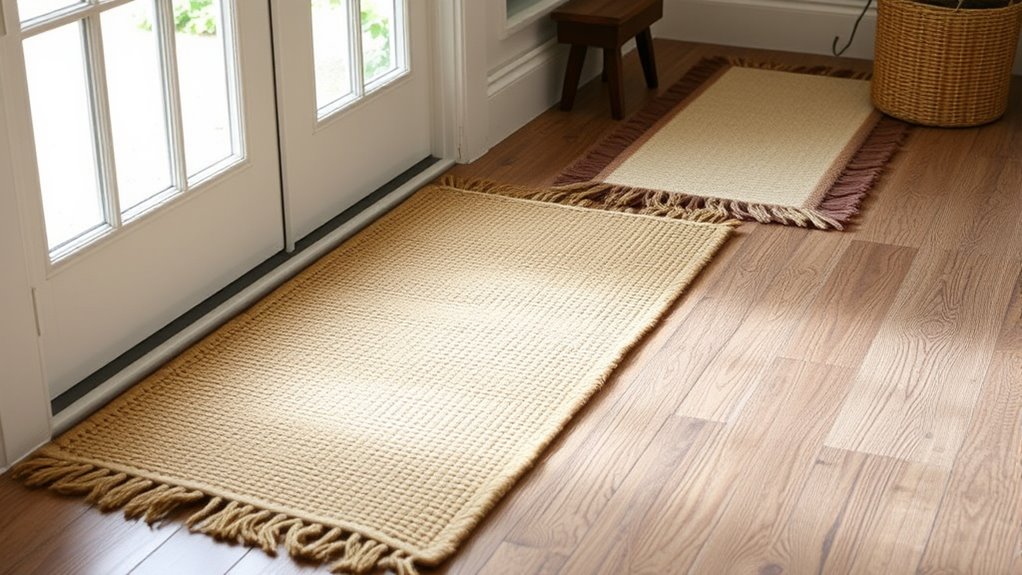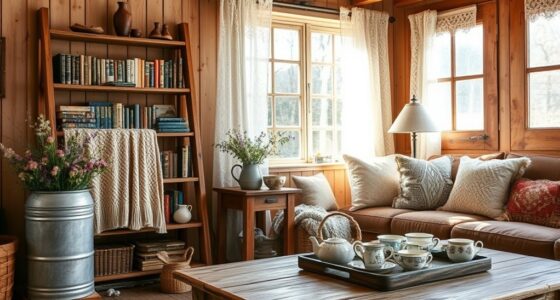Imagine your farmhouse space as a woven tapestry, where each rug adds depth and character to the overall picture. Layering rugs might seem straightforward, but it’s an art that balances style and comfort. The right combination can make your home feel warm and inviting, yet it’s easy to slip into chaos if you don’t understand the nuances. Curious how to achieve that perfect rustic harmony? There’s more to it than just piling rugs—let’s explore how to do it right.
Key Takeaways
- Select varied sizes and shapes, layering large rugs under furniture with smaller rugs for accents or entryways.
- Use a cohesive color palette and complementary patterns to ensure harmony among layered rugs.
- Mix natural textures like jute, wool, and cotton for added depth and tactile interest.
- Anchor your space with a main vintage or rustic-patterned rug, then add textured accents for visual warmth.
- Regularly rotate and update rug layers seasonally to maintain freshness and highlight different textures and patterns.
Choosing the Right Rug Sizes and Shapes
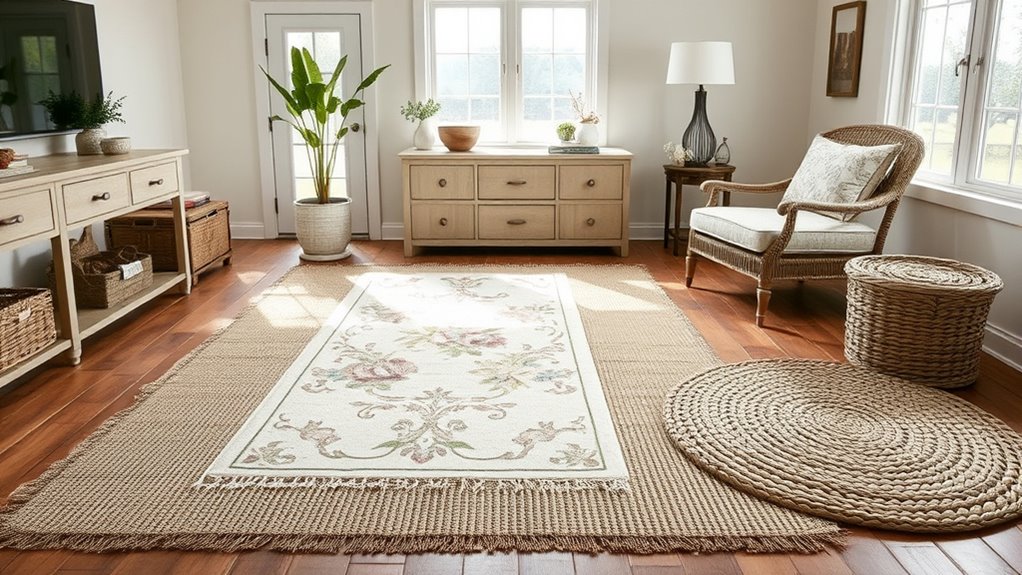
Selecting the right rug sizes and shapes is essential to achieving a balanced and inviting farmhouse look. For a vintage farmhouse style, choose rugs that complement your space’s rustic charm.
Large rugs work well in open living areas, anchoring furniture and creating a cozy atmosphere. Smaller, rectangular or round rugs suit entryways or under dining tables, adding warmth and visual interest.
Mixing different shapes, like a rectangular rug layered with a round one, enhances the layered effect. Keep proportions in mind: rugs should be big enough to frame your furniture or focal points without overwhelming the room.
Selecting Complementary Colors and Patterns
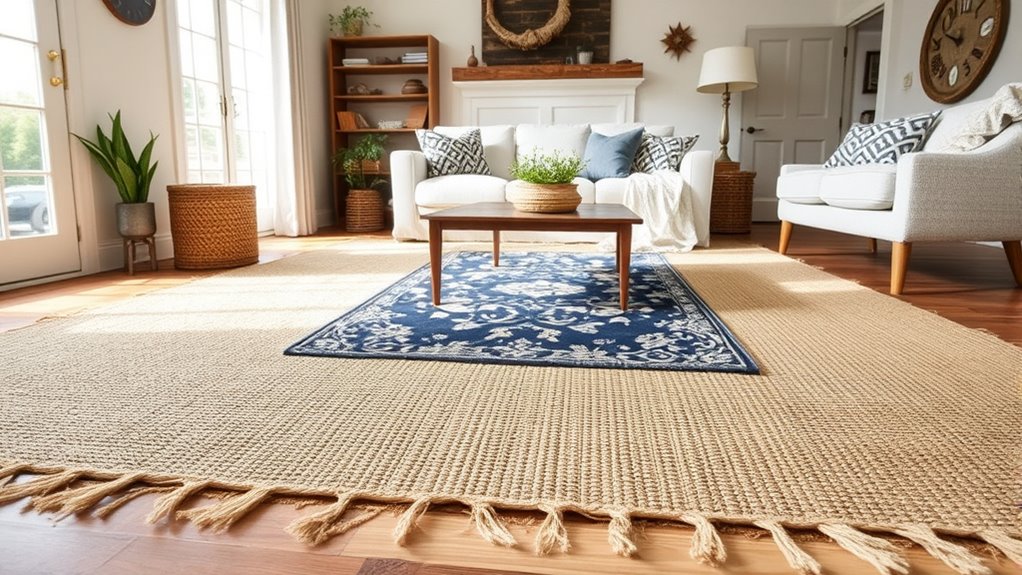
After choosing the right sizes and shapes for your layered rugs, it’s time to focus on their colors and patterns. Achieving good color harmony guarantees your rugs complement each other and your farmhouse decor. Pattern coordination is key—mixing different patterns without clashing creates visual interest. Incorporating visual harmony can help ensure your rug layers work well together. Use this table for inspiration:
| Rug 1 | Rug 2 | Rug 3 |
|---|---|---|
| Neutral solid | Classic stripes | Subtle floral |
| Warm earth tones | Coordinating geometric | Plaid pattern |
| Light background | Slightly contrasting | Coordinated colors |
Stick to a cohesive color palette and varying but compatible patterns to create a balanced, farmhouse-inspired layered look.
Prioritizing Texture and Material Mixes

To create a cozy farmhouse look, focus on mixing different textures and natural fibers. Combining rugs made from jute, wool, and linen adds depth and visual interest to your space. Incorporating self-watering planters can also introduce greenery that complements the layered rugs and enhances the natural aesthetic. Varying rug textures keeps the layered look inviting and rich without feeling overwhelming.
Mix Natural Fibers
Mixing natural fibers is a key step in creating a warm, inviting farmhouse look. By combining rugs made from jute, sisal, wool, and cotton, you add visual interest and depth to your space. Natural fibers not only enhance texture but also contribute to rug durability, ensuring your layered setup withstands daily wear. Using a proper inflation technique on your rug’s foundation can also help maintain its shape and longevity. For example, pairing a coarse jute rug with a softer wool one creates contrast while keeping the overall aesthetic cozy. Remember, mixing fibers should feel intentional, balancing rougher textures with smoother ones to achieve a harmonious look. Incorporating different natural fibers also emphasizes the rustic charm typical of farmhouse style, making your space feel thoughtfully curated and welcoming.
Vary Rug Textures
Varying rug textures is essential for adding depth and visual interest to your farmhouse space. Mixing different textures creates a layered, inviting look that feels both cozy and curated.
Incorporate vintage patterns to bring a touch of history and charm, pairing them with rustic textures like jute or sisal for an organic feel.
Combining plush, soft rugs with rougher, natural fibers adds contrast and enhances the tactile experience. Don’t shy away from mixing materials such as woven wool with leather or faux fur for richness.
This variation not only highlights different textures but also keeps the space dynamic and warm. Additionally, maintenance and cleaning techniques are crucial for preserving the integrity and appearance of textured rugs over time.
Anchoring Your Layers With a Main Rug
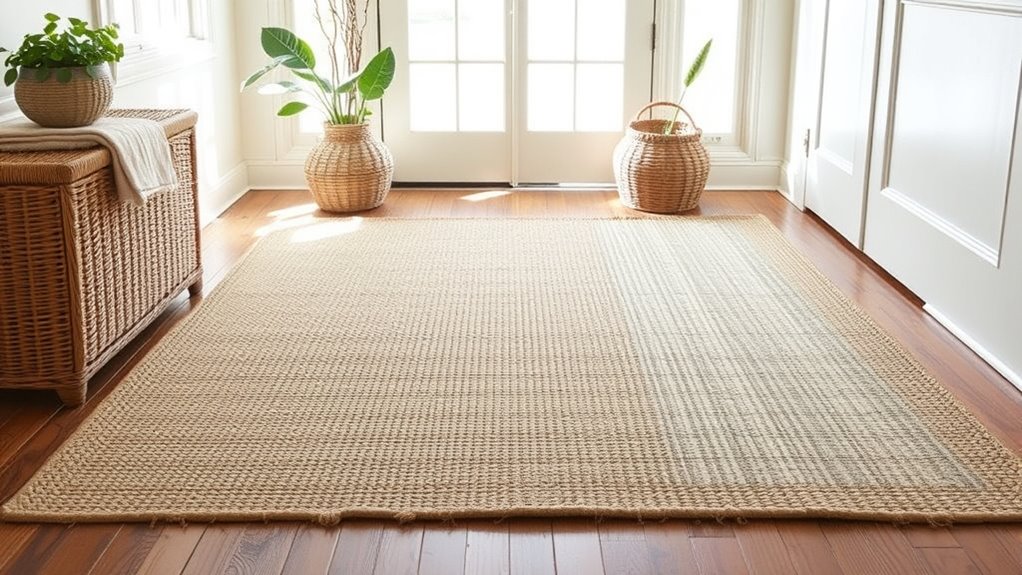
A main rug acts as the foundation for your layered farmhouse look, helping to define the space and set the tone for your decor. Choose a rug with vintage patterns or rustic motifs to evoke charm and authenticity. This centerpiece anchors your layered design, providing a visual base that ties the other rugs together. Incorporating strong communication skills can help you articulate your decorating vision clearly when collaborating with others or seeking inspiration. Opt for a neutral color palette or faded hues to complement your farmhouse aesthetic. Make sure the main rug is large enough to anchor furniture and create a cohesive look. Its style should balance simplicity and character, serving as a versatile backdrop for additional layers.
Adding Textural Accents With Smaller Rugs
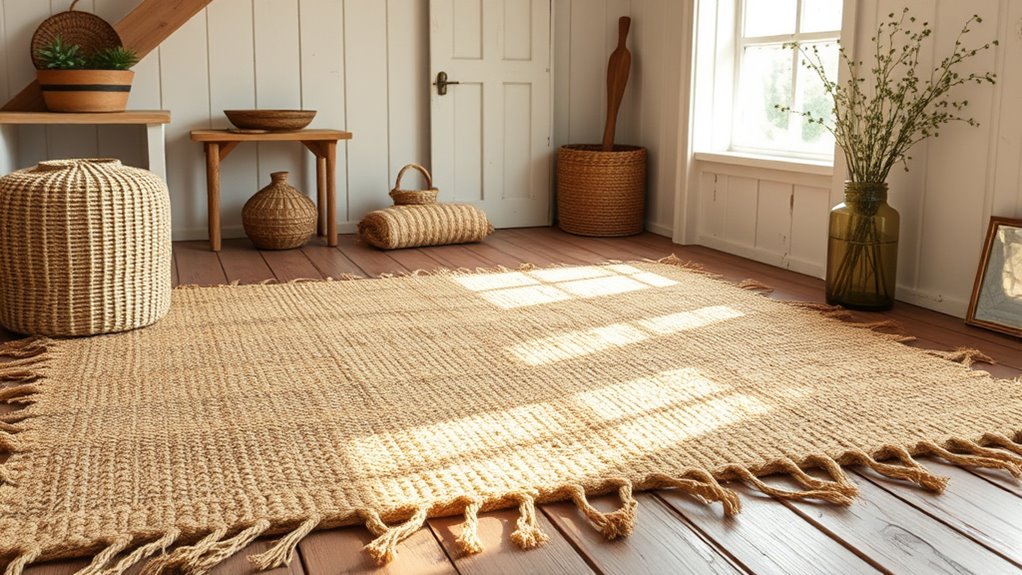
Adding textural accents with smaller rugs is a simple way to bring depth and tactile interest to your farmhouse layered look. These smaller rugs create cozy layering that invites foot traffic and adds visual warmth. Choose rugs with different textures—think jute, braided, or shaggy—to enhance the tactile variety. Placing a small, textured rug over a larger one emphasizes contrast and adds dimension without overwhelming the space. Use these accents in areas like entryways, under accent chairs, or in front of sinks to highlight specific zones. The key is to select rugs that complement your main layers while adding just enough visual interest. Incorporating attention into your placement ensures each rug contributes to a cohesive and inviting atmosphere. This approach makes your farmhouse style feel inviting and thoughtfully layered with an effortless, cozy charm.
Arranging Rugs for Balance and Flow

Achieving balance and flow when arranging rugs in your farmhouse space transforms the room into a cohesive and inviting environment. Start by considering your vintage accents and how they complement your rug layers. Incorporate natural materials in your rug choices to enhance the authenticity of the farmhouse style. Place larger rugs under key furniture pieces, like sofas and dining tables, ensuring they extend beyond the edges for a grounded look. Use furniture placement to create natural pathways, guiding the eye smoothly through the space. Layer smaller rugs over larger ones in areas where you want to highlight vintage accents or seating zones. Keep the arrangement balanced by avoiding overcrowding one side or corner. Aim for a harmonious mix of textures, colors, and patterns that flow seamlessly, making your farmhouse feel warm and thoughtfully curated.
Tips for Maintaining and Updating Your Layers
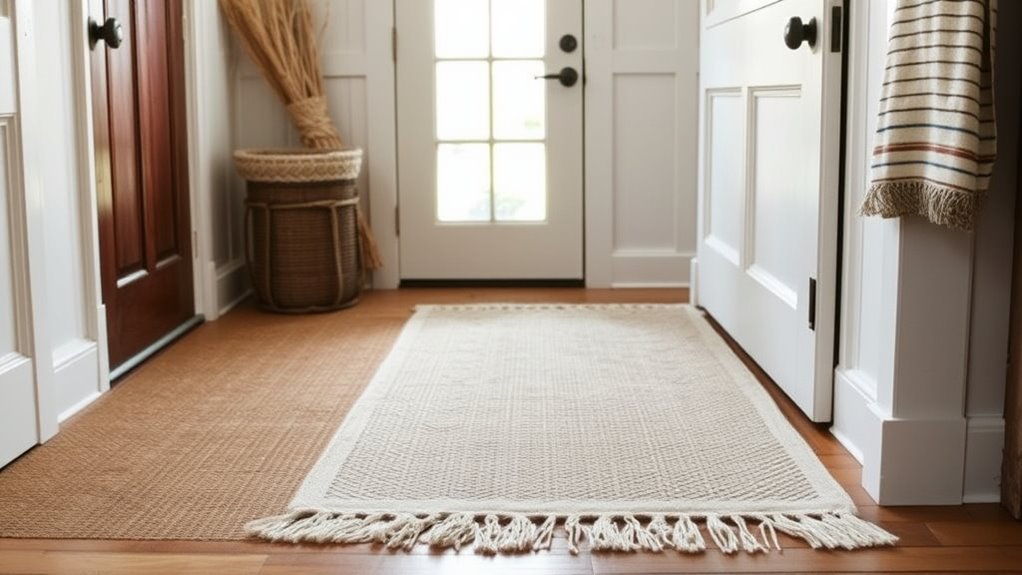
To keep your layered rugs looking fresh, try adding new textures that complement your existing decor. Rotating your rugs periodically can also give your space a new feel without a full overhaul. Incorporating wider tires can inspire you to explore different rug styles for your farmhouse look. These simple updates help maintain your farmhouse style while keeping your floors interesting.
Refresh With New Textures
Revitalizing your layered rugs with new textures keeps your farmhouse style looking invigorated and inviting. To achieve this, consider swapping out rugs with vintage patterns for ones that add a tactile element, like woven jutes or shaggy textures. Incorporating proper storage techniques can help preserve the quality of your rugs and keep them looking fresh over time. Mixing in rugs with neutral palettes enhances the layered look without overwhelming the space. You can update your layers by introducing different textures—think plush, coarse, or ribbed—while maintaining a cohesive color scheme. This approach keeps your decor fresh and lively, emphasizing comfort and authenticity. Regularly renewing textures prevents your farmhouse space from feeling static, making it more dynamic and welcoming.
Rotate for Freshness
Ever wondered how to keep your farmhouse rug layers looking fresh over time? Rotating your rugs is a simple way to do it. By swapping out seasonal rugs, you introduce new textures and colors that reflect the time of year, giving your space an instant update.
Plus, rotating allows you to spot any wear or damage early, so you can clean or replace areas as needed. Don’t forget scent enhancements—adding a subtle drop of essential oil on a rug pad or using lightly scented sprays can refresh the space and keep it smelling inviting.
Regular rotation keeps your layered rugs feeling new and vibrant, maintaining that cozy farmhouse charm while protecting your investment. It’s a quick, effective trick to stay inspired and keep your decor looking its best. Incorporating rug maintenance routines can also extend the life of your rugs and preserve their appearance over time.
Frequently Asked Questions
How Do I Choose Rugs That Withstand High-Traffic Areas?
When choosing rugs for high-traffic areas, you want to prioritize rug durability and stain resistance. Look for materials like wool, nylon, or polypropylene, which stand up well to wear and tear.
Opt for low-pile or tightly woven rugs, making them easier to clean and less likely to trap dirt. These choices guarantee your rugs stay looking great longer, even with constant foot traffic.
Can Layered Rugs Improve Acoustics in a Farmhouse?
Layered rugs can definitely improve acoustics in your farmhouse by enhancing sound absorption. The multiple textures and thicknesses break up sound waves, reducing echo and noise.
Plus, they add to your decorating style, creating a cozy, inviting atmosphere. By combining different patterns and materials, you not only boost soundproofing but also achieve a layered look that complements your farmhouse decor beautifully.
What Are Eco-Friendly Rug Options for Farmhouse Layering?
You’re in luck—there are eco-friendly rug options perfect for farmhouse layering. Think about rugs made from sustainable fibers like jute, sisal, or organic cotton, which are both durable and natural.
Opt for those dyed with natural dyes to keep your decor eco-conscious. It’s a win-win; you get stylish layers that don’t harm the environment, proving that good things come in sustainable packages.
How Do I Prevent Rugs From Slipping on Uneven Floors?
To prevent rugs from slipping on uneven floors, you should use non-slip pads underneath each rug. These pads help grip both the rug and the floor, providing extra stability.
Additionally, consider rug anchors or tacks for added security, especially in high-traffic areas. Be sure to choose pads and anchors compatible with your flooring type.
This way, your layered farmhouse rugs stay in place, safe and stylish.
Are There Seasonal Tips for Updating Layered Farmhouse Rugs?
You can easily update your layered farmhouse rugs seasonally by swapping in new pieces with seasonal color updates. For winter, choose cozy, warm-toned rugs, and for summer, go for lighter, brighter shades.
Incorporate holiday rug accents during festive seasons to add charm. This quick change keeps your farmhouse style fresh and inviting year-round.
Allowing you to celebrate each season with thoughtful, stylish updates that enhance your layered rug look.
Conclusion
Layering rugs in your farmhouse style creates a warm, inviting space you’ll love coming home to. Don’t worry if it feels a little busy at first—you’re building a cozy haven that reflects your rustic charm. Imagine sinking your feet into soft wool and jute textures, with vintage patterns tying everything together. With a little patience, your layered rugs will transform your room into a charming, timeless retreat that feels both stylish and welcoming.

